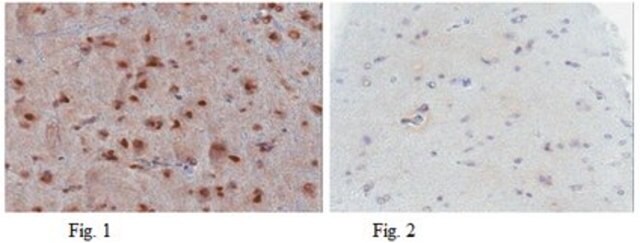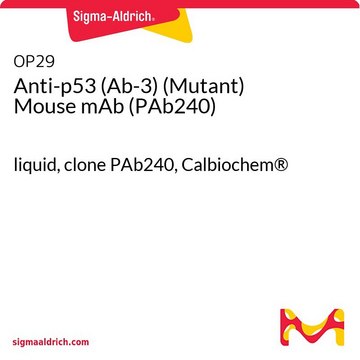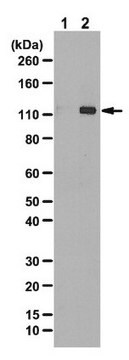CBL404
Anti-p53 Antibody, aa 211-220, clone240
clone PAb240, Chemicon®, from mouse
Synonim(y):
Przeciwciało anty-p53
About This Item
Polecane produkty
pochodzenie biologiczne
mouse
Poziom jakości
forma przeciwciała
purified antibody
rodzaj przeciwciała
primary antibodies
klon
PAb240, monoclonal
reaktywność gatunkowa
hamster, monkey, mouse, chicken, human, rat, bovine
producent / nazwa handlowa
Chemicon®
metody
immunohistochemistry: suitable
immunoprecipitation (IP): suitable
western blot: suitable
izotyp
IgG1
przydatność
not suitable for immunohistochemistry (Paraffin)
numer dostępu NCBI
numer dostępu UniProt
Warunki transportu
wet ice
informacje o genach
human ... TP53(7157)
Opis ogólny
a) Most of them are missense point mutations giving rise to an altered protein function.
b) Many -but not all- mutant p53 proteins exhibit a common mutant structure, which can be recognized by monoclonal antibodies specific for p53 in the mutant conformation.
Specyficzność
Immunogen
Zastosowanie
Detection of mutant p53
Prevalence of detection using CBL 404
-50% colon carcinoma sections positive (30 samples)
-70% lung carcinoma sections positive (50 samples)
-30% carcinoma breast samples positive (50 samples)
Normal and pre-malignant tissues negative
Reacts on methacarn fixed tissue
Optimal working dilutions must be determined by the end user.
Epigenetics & Nuclear Function
Transcription Factors
Powiązanie
Postać fizyczna
Przechowywanie i stabilność
Informacje prawne
Oświadczenie o zrzeczeniu się odpowiedzialności
Nie możesz znaleźć właściwego produktu?
Wypróbuj nasz Narzędzie selektora produktów.
polecane
Kod klasy składowania
12 - Non Combustible Liquids
Klasa zagrożenia wodnego (WGK)
WGK 1
Temperatura zapłonu (°F)
Not applicable
Temperatura zapłonu (°C)
Not applicable
Certyfikaty analizy (CoA)
Poszukaj Certyfikaty analizy (CoA), wpisując numer partii/serii produktów. Numery serii i partii można znaleźć na etykiecie produktu po słowach „seria” lub „partia”.
Masz już ten produkt?
Dokumenty związane z niedawno zakupionymi produktami zostały zamieszczone w Bibliotece dokumentów.
Nasz zespół naukowców ma doświadczenie we wszystkich obszarach badań, w tym w naukach przyrodniczych, materiałoznawstwie, syntezie chemicznej, chromatografii, analityce i wielu innych dziedzinach.
Skontaktuj się z zespołem ds. pomocy technicznej








